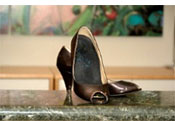 With painful conditions like nerve inflammation (called a Morton’s neuroma), bursitis, bunions, hammertoes, nail damage, ankle sprains and tight tendons (equinus), high heels can come at a high price. There is good news though! It is not necessary to give up high heels forever. Following these tips can help take the hurt out of this guilty pleasure.
With painful conditions like nerve inflammation (called a Morton’s neuroma), bursitis, bunions, hammertoes, nail damage, ankle sprains and tight tendons (equinus), high heels can come at a high price. There is good news though! It is not necessary to give up high heels forever. Following these tips can help take the hurt out of this guilty pleasure.
No higher than about 2 inches for a pair you intend to wear all day long.
The widest part of the shoe should fit the widest part of your foot.
Seek out high quality, soft, leather materials.
Don’t wear high heels every day. Have a “balanced shoe diet”.
Thicker, wider heels and wedges are easier to balance on than a thin spikey heel.
Use a dress orthotic like Slender Fit PowerSteps to help support your arch and add cushioning.
Strengthen the intrinsic muscles of your foot with “pick up” exercises. There are tiny muscles in the feet that move the toes up, down and side to side. Strong intrinsics help with keeping high heeled shoes on your feet and sense your position in space.
Strengthen your ankles with resistance band exercises. Strong, flexible ankles are better at resisting falls and sprains.
Take a shoe break midday and switch to a lower heel.
Fight friction spots with gel pads.
When commuting wear a comfortable walking shoe then switch to the heels at work.
Stretch your Achilles tendon with the heel drop exercise after wearing heels.
Ice massage the bottom of your foot with a frozen water bottle.
Here’s another great tip to keep your high heels in great shape:
Use baby wipes to gently clean any accumulated sweat and other gunk on the inside of a high heel.